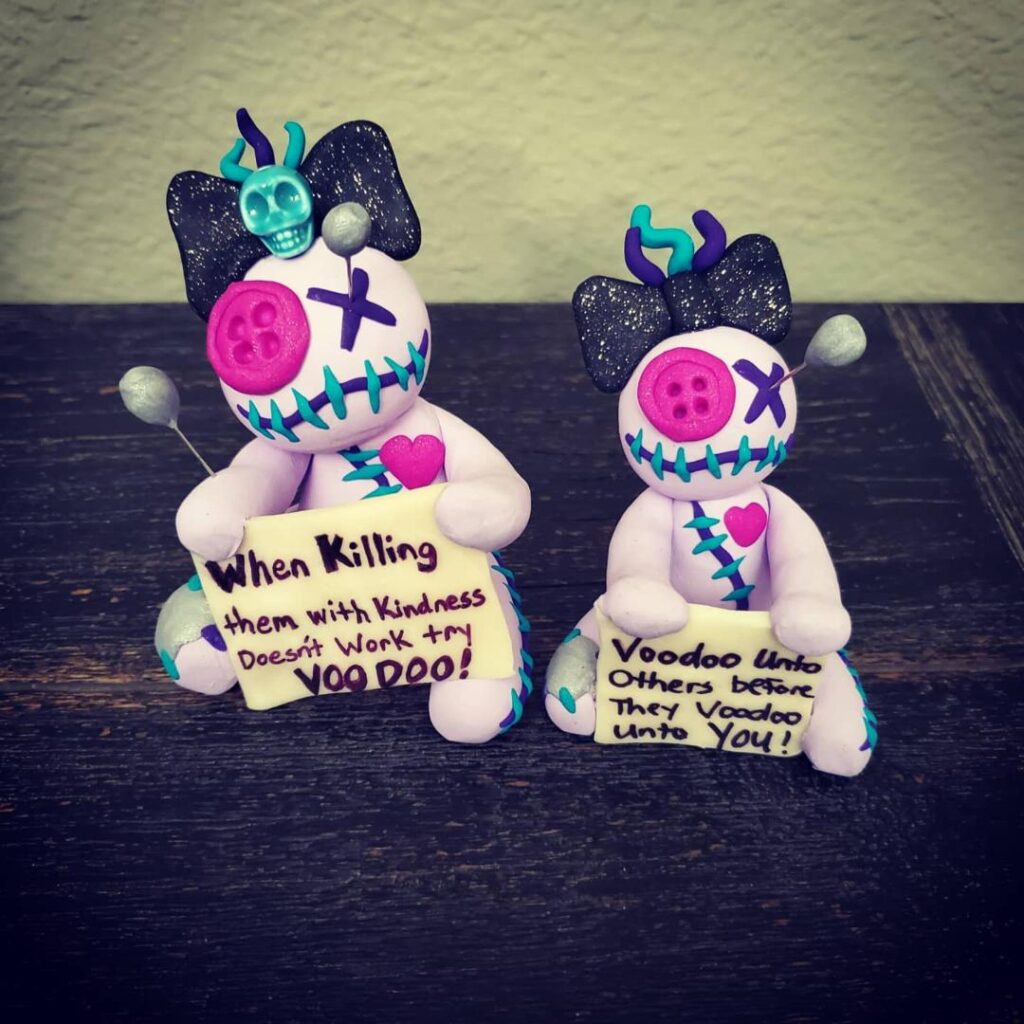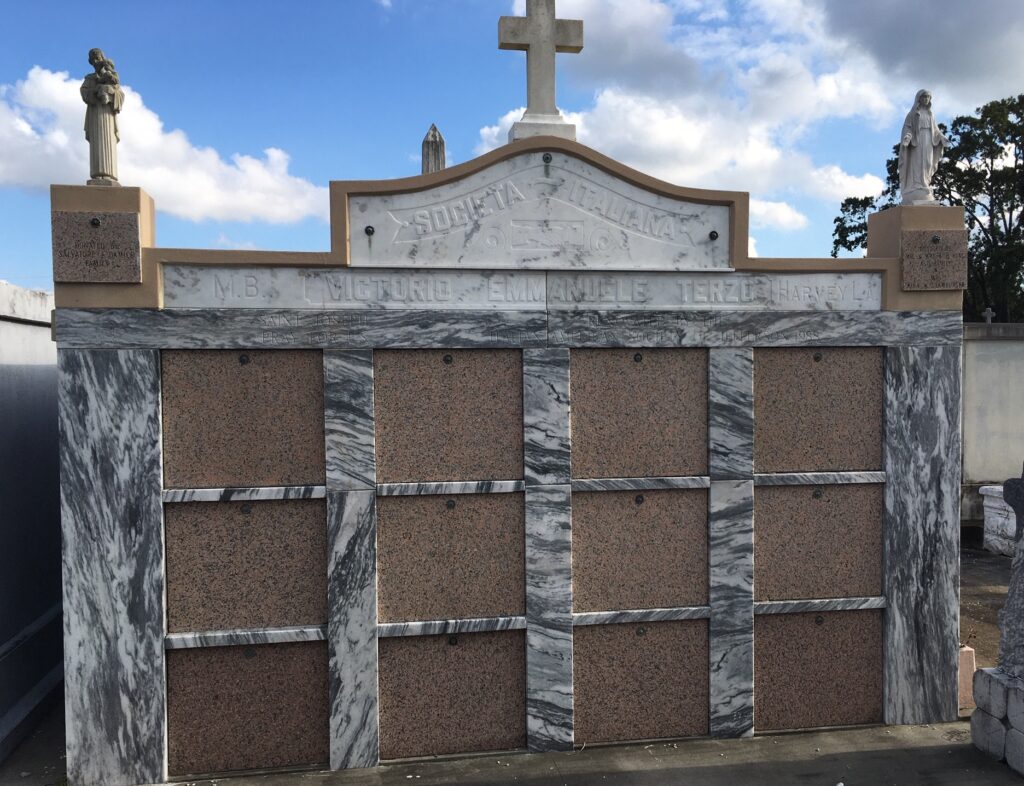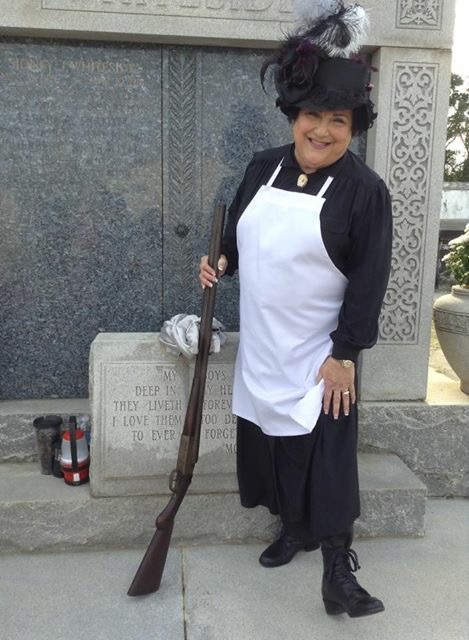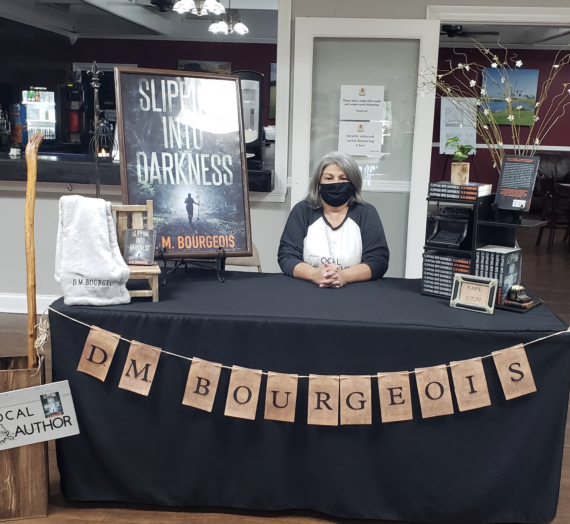Meagababy, Mystery & Murder…
Meagababy, aka Meagan Martinez, the artist who hides her art in cemeteries was in full-face ghoulish makeup when she stopped by Hook and Ladder Cemetery to check out the happenings there this close to Halloween and All Saints Day. http://gretnaglance.com/meagababy-hides-in-hook-ladder-cemetery/
Or, perhaps she was hoping to stumble across the grave of her great grandmother on her mother’s side, Eva Vidonne whose grave there is yet to be found.

A multi-faceted artist, Meagababy flexes her creative muscle in various mediums, from stunning full-on body makeup to sugar skull art to creating voodoo dolls that are selling like crazy due to her newly created Meagababy Makeup Facebook live video “Cocktails and Chaos!” every Friday at 7 p.m.
“On the video, as we drink and party, I showcase my latest art for sale and do a “giveaway,” giving away my own art, as well the work of other talented artists’ that I promote on the show,” Meagababy said. “Some of my more popular pieces are small clay critters, often depicting its personality.”
“As a New Orleans Sugar Skull Specialist, I create Day of the Dead sugar skull makeup. I believe in honoring the dead and love the traditions of “Dia de los Muertos” (Day of the Dead), a tradition started as a Mexican celebration of loved ones that have passed, similar to the Roman Catholic holiday, “All Soul’s Day.”

“Sugar skulls represent a departed soul with the name written on the forehead and placed on the gravestone to honor the return of a certain spirit. Sugar skull art reflects the folk art style of big happy smiles, colorful icing and sparkly adornments.
“My friends and family call me the Halloween Queen and my husband and I, of course, met on Halloween. We will be celebrating our anniversary on Nov. 1, All Saints Day!
Meagababy is full of fun and trickery, but there is an eerie story with true ties to Hook and Ladder that is far from fun! The story is about a little angel who has been a resident in the historic cemetery since March 1919.
It all goes back to the early 20th century when a murderer known as the “Axeman of New Orleans” held the city paralyzed with fear. In the dead of night, the “Axeman” broke into a series of Italian groceries, attacking the grocers and their families. Many he left wounded; four people he left dead. The attacks were vicious. Joseph Maggio, for example, had his skull fractured with his own axe, his throat cut with a razor. His wife, Catherine had her throat cut and asphyxiated on her own blood as she bled out. www.smithsonianmag.com › author › miriam-davis

The Axeman struck from 1917 to March 1919. As the killer’s epithet implies, the victims usually were attacked with an axe, often belonging to the victims. In most cases, a panel on a back door of the home was removed by a chisel, which along with the panel was left on the floor near the door. The intruder then attacked one or more of the residents with either an axe or straight razor. The crimes were not motivated by robbery. The perpetrator never removed items from his victims’ homes. New Orleanians were terrified!
Then, the killer crossed the river to GRETNA. On the night of March 10, 1919 he assaulted Charlie Cortimiglia in his familiar way, badly injuring Charlie and his wife, Rosie and killing their two-year-old daughter, Mary.
Young Mary Cortimiglia was killed with a single blow to the back of the neck while sleeping in her mother’s arms. Little Mary is buried in Hook and Ladder Cemetery in the Societa-Italiana, the Italian Society Tomb.
The small immigrant family lived on the corner of Jefferson Avenue and 2nd Street. On the night of March 10, 1919 screams were heard coming from the Cortimiglia residence.
The grocer Iorlando Jordano rushed across the street to discover that the Cortimiglias had been attacked. The assailant had fled. Rosie stood in the doorway with a serious head injury, clutching her dead daughter while Charles lay bleeding profusely on the floor. The couple were taken to Charity Hospital, both suffered skull fractures. Nothing was stolen from the house, but a panel on the back door had been chiseled away and a bloody axe was found on the back porch.
Upon gaining full consciousness in the hospital, Rosie made claims that Iorlando Jordano and his 18-year-old son, Frank were responsible for the attacks. Iorlando, a 69-year-old man, was in too poor of health to have committed the crimes. Frank Jordano, over six feet tall and weighing over 200 pounds was too large to fit through the open panel on the back door. Charles Cortimiglia vehemently denied his wife’s claims, yet police nonetheless arrested the two and charged them with murder. Found guilty, Frank was sentenced to hang and his father, to life in prison.
Charles Cortimiglia divorced his wife after the trial. Nine months later, Rosie walked into the Times-Picayune newspaper office to retract her testimony. She said that St. Joseph had come to her in a dream and told her she had to tell the truth. Rosie admitted that she had falsely accused the two out of jealousy and spite. As grocers, they were business competitors of the Cortimiglias who had taken the Jordanos to court over a business dispute shortly before the attack. Her statement was the only evidence against the Jordanos and both father and son finally walked free.
Many believed that the Axeman murders were connected with the Mafia or the Black Hand, perhaps a blackmail and racial attempt on Italian grocers. However, detective John Dantonio, a nationally known expert on the Mafia, rejected the idea, saying that a Black Hand attack wouldn’t have left any survivors as the Axeman frequently did. He too agreed with N. O. Police Supt. Frank Mooney who was convinced that the attacks were the work of a “fiend, a Jekyll and Hyde personality, like Jack the Ripper. Suddenly the impulse to kill comes upon him and he must obey it.” In other words, what we’d now call a serial killer.
The Axeman was never caught or identified and his crime spree stopped as mysteriously as it had started, his identity remains unknown to this day. The Axeman was also called the Jazzman, derived from a letter attributed to the killer in which he stated that he would spare the lives of those who played jazz in their homes. https://en.wikipedia.org/wiki/Axeman_of_New_Orleans
Besides the loss of Gretna Goblin Night on Halloween due to the Covid-19 pandemic was the cancellation of Gretna Historical Society’s 8th Annual Hook and Ladder Cemetery Tour where proceeds go toward restoration of the cemetery. https://www.nola.com/news/article_f42d22d8-c251-54ad-b98f-500a304708d8.html
The popular October event showcases some of the people buried there who helped shape Gretna in both character and history.
The story of young Mary Cortimiglia and the Axeman was told through the depiction of her “mother” in previous cemetery tours. Lisa LaFrance and Machelle Hall each portrayed Rosie Cortimiglia.
A well-known character of the tour who had the privilege of being featured in some way every year was Emily Kerner Whiteside, or just simply “Emma.”

Emma was a very colorful character who was a successful restaurateur in Gretna from the early 1930’s until her death in 1962. She often solved problems with the threat of her trusty shotgun, often found herself in trouble with the law, but always walked away legally unscathed.
The tour each year begins at the Red Maple Restaurant on property purchased in 1905 by Emma to build her home, the only part of the entire block that is not cemetery ground. Tour guests are served dinner before they are guided through the historic cemetery to meet its “residents.”
Emma, who is buried in Hook & Ladder was a strong woman, born of privilege who found herself widowed and broke with three sons yet not grown. She picked herself up and started Whiteside’s, a restaurant that became the most popular family restaurant in Gretna for many years.
Beyond her take-hold manner with a shotgun, both mean and feisty, yet smart and hardworking Emma is to be admired. She went from privileged to poor and successfully worked her way back to a life on easy street, wanting for nothing financially.
###




Sevilla Finley
great Halloween story n Gretna urban legend. Thanks Helen.
Claire Olsen Flannery
Really enjoyed reading the story about
Gretna history! Remember Whiteside’s
restaurant as it was close to my house
and ate there several times!!!